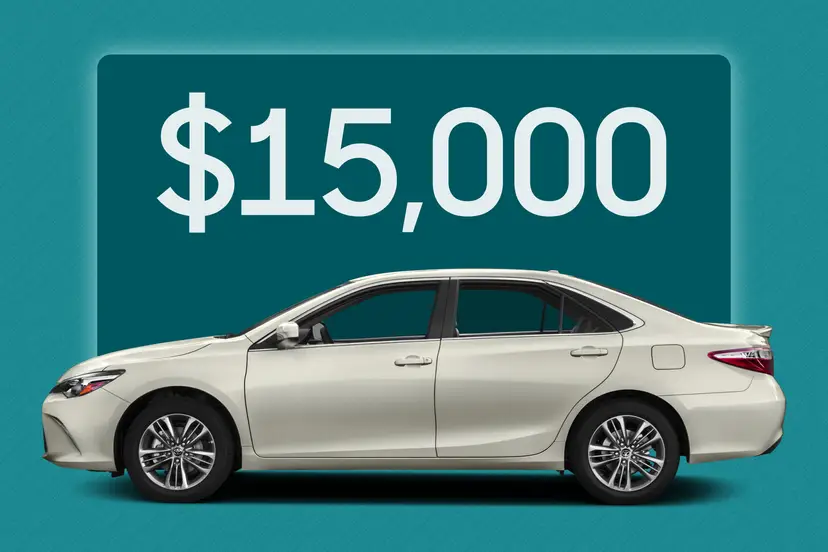
The verdict: The redesigned 2017 Buick LaCrosse’s interior remains firmly in the near-luxury class, rather than taking the next leap in quality, but the LaCrosse drives like a luxury car many times more expensive than it is.
Versus the competition: The LaCrosse’s exceedingly comfortable ride with 18-inch wheels is refreshing considering how many near-luxury competitors want to be the sporty type and end up being neither sporty nor comfortable.
The 2017 Buick LaCrosse is about as all-new as you can get without slapping a new name on the trunk. The retooling of the platform and everything above it has transformed the 2017 LaCrosse into one of the quietest sedans this side of a Mercedes S-Class. And when properly equipped, the LaCrosse is much more than a wallowing, numb-driving geriatric special; it showcases a surprisingly capable driving experience that matches its sleek new look.
Related: 2017 Buick LaCrosse: First Look
Exterior & Styling
This new LaCrosse looks very different from the snooze-fest it replaces. Longer, lower and wider dimensions give the LaCrosse a considerably sleeker appearance. And, boy, is it long. At 197.5 inches from bumper to bumper, it’s 4.2 inches longer than a Lexus ES 350, 4.7 inches longer than a Nissan Maxima and 7.2 inches longer than an Acura TLX. Compare the LaCrosse’s specs to those of its competitors here.
The new LaCrosse looks massive driving down the road despite being as much as 297 pounds lighter than the outgoing one (compare the 2017 with the 2016 here). Notable highlights of the exterior redesign include the new Buick “tri-shield” insignia on the grille and trunk. It’s painted red, silver and blue and gives a nice pop of color to an otherwise conservative collection of exterior color choices.
How It Drives
There are essentially two types of LaCrosse to be had: Sporty Spice and Old Spice. Versions with 20-inch wheels include a unique adaptive suspension for a sportier drive, while cars with the 18-inch combo are the more traditional, comfortable-driving car to which current LaCrosse owners will be accustomed. These 20- and 18-inch wheel packages are the equivalent of Sport and Touring trims, respectively, and both use a new 310-horsepower, 3.6-liter V6 mated to an 8-speed automatic transmission. LaCrosse trims include Standard ($32,990 with destination charge), Preferred ($36,990) and Essence ($39,590), which are front-wheel drive, and the top trim, Premium ($41,990), which can be had with front-wheel drive or a new twin-clutch AWD system ($2,200) that’s able to split torque both front to rear and between the left and right rear wheels for improved handling.
GM-Buick invited us to drive both versions in Portland, Ore. — home to some of the loudest pavement in the country, with coarse, sandpaper-like highways that pour gritty road noise into the cabin for miles. The LaCrosse development team targeted the Lexus ES 350 for performance benchmarks in noise levels, and the LaCrosse was the quieter, better-driving car of the two any way they’re sliced. The Buick’s new, stronger platform is 297 pounds lighter than that of the outgoing LaCrosse and has a longer wheelbase and wider track, meaning the 2017 is a thoroughly different car from the outgoing LaCrosse.
The real surprise of the show is the LaCrosse’s optional 20-inch wheel package ($1,625), which is much more than simply a tire and wheel combo: It pairs with Buick’s Continuous Damping Control adaptive suspension, which is available on Essence and Premium trims. With it, drivers can choose between a comfortable, soft suspension (Touring mode) or stiffer, performance-tuned damping in Sport mode that heightens handling and backroad fun. The ES 350, Acura TLX and Nissan Maxima can’t match that kind of ride-quality customization because they lack adjustable suspension firmness. Lincoln’s MKZ has an adjustable-firmness suspension, however, and it’s standard equipment.
LaCrosses with the 20-inch wheels unleash their most-proficient handling in Sport mode, where increased suspension firmness flattens out handling and increases turn-in responsiveness to the point where it’s entertaining to drive the car spiritedly, even if that’s not something that will come naturally to most owners. Sport mode also increases steering wheel weighting, holds lower transmission gears longer and transfers more lb-ft of torque to the rear wheels in AWD models.
A LaCrosse with 18-inch wheels, though, is a car you can spend hours driving without a flinch of a lower back spasm. There’s no Sport mode — not even for transmission or steering tuning — and the supple ride of the fixed-firmness suspension is specifically tuned to the wheel and tire package. The 18-inch tires have taller sidewalls than the 20-inch wheels to better absorb road imperfections.
With the 18s, I couldn’t hear a whisper from the engine and caught only a faint, distant whistling of the wind over the side mirrors. Standard active noise cancelling and a host of features in Buick’s “Quiet Tuning” strategy — including an acoustic-laminated windshield and front-door windows — keep the cabin quiet, and a new five-link rear suspension improves road noise isolation over the previous, four-link rear suspension design. Traveling over a freshly paved highway at 60 mph in a car with the 18-inch package, you could have told me I was driving an electric car — that’s how quiet the new LaCrosse can be.
Interior
The LaCrosse’s optional leather-appointed front seats replace the standard leatherette (imitation leather) upholstery and are supportive and plush; their design and stitching are among the interior’s highlights, especially when you choose the classy brandy leather color. Premium trims have a massaging lumbar function, though it’s mostly a novelty, with only a shred of the range that higher-end massaging systems have. For rear passengers, the seatback rests at a slightly reclined angle and provides a comfortable position, with cushioning as soft as the front. At 6 feet tall I didn’t have any problem with headroom or legroom, but a slightly taller editor found backseat headroom limited.
The rest of the interior quality doesn’t do much to pull the LaCrosse out of the “near-luxury” category Buick shares with Acura and Lincoln. The nicely appointed ES 350 and even the Maxima have an edge over it in materials quality and luxurious styling. Holding the LaCrosse back is faux wood trim plastered in highly visible areas of the interior, plus low-grade paneling and pockets below the door handle that look straight from a non-luxury compact or midsize sedan.
An even more questionable inclusion is the new electronic gear selector. Like the Cadillac XT5 SUV that shares it, the selector layout takes time to learn. In my opinion, if you have to pause, think about it or get used to it, the setup has unneeded complexity. The space this electronic lever frees up under the center console is useful, but I found the gear engagement unsatisfying and frequently questioned which gear I’d chosen. The slender gear selector also hasn’t narrowed the front center console any, and the LaCrosse’s large, tall console with gear selector, cupholders and storage bin contributes to the car feeling small for front occupants despite its large exterior dimensions and wide backseat.
Ergonomics & Electronics
If you can look past the fact that the LaCrosse’s materials aren’t as rich as that of a Lexus, you’ll be treated to desirable multimedia features. The large touch-screen is complemented by tuning buttons and a volume knob instead of gimmicky touch-sensitive capacitive buttons, and the always-welcome Apple CarPlay and Android Auto are standard.
In-car Wi-Fi with an OnStar 4G LTE data plan is ripe for using phones, tablets and laptops in the car. The first three months or 3 gigabytes of data is included before a monthly plan is required to keep the service going. Plans start at $10 a month for 1 GB of data. Two USB ports up front and an AC household outlet in the back on Premium trims supply power for long trips.
Cargo & Storage
The LaCrosse has 15 cubic feet of trunk space, which is up from 13.3 cubic feet in the outgoing LaCrosse. The new trunk can fit four bags of golf clubs rather than the old car’s three. Pressing the Buick insignia unlatches the trunk (in lieu of a release near the license plate or under the trunk lip). There’s also a split, folding backseat to fit longer items. While a folding backseat may seem like a no-brainer inclusion, some large sedans, like the Lexus ES 350 and related Toyota Avalon, only offer small pass-through openings in a fixed backseat. Folding the LaCrosse’s backseat is a cinch, with releases in the trunk for either side.
Safety
As of this writing, the LaCrosse hasn’t been crash-tested. Go here to see a full list of standard safety features. Available safety features include forward collision warning with automatic emergency braking, blind spot warning, lane change assist and rear cross-traffic alert.
A standard teen driver feature provides a driving report card for parents: In-car alerts can be set for predetermined speeds, while Bluetooth phone and audio from the stereo can be muted when the front seat belts aren’t fastened.
Value in Its Class
Thanks to the LaCrosse’s noticeable shortcoming in interior quality, the 2017 isn’t a serious luxury competitor to the Lexus ES 350, but the LaCrosse beats that car in every driving category (quietness, sportiness, comfort) and is a serious value, including the desirable Apple CarPlay and Android Auto, AWD and adjustable firmness suspension that the ES lacks. The two latter options, however, are available only on higher trim levels, so be prepared to look at a $45,000 LaCrosse to get the optimal experience.
Also limited to the top trim is a precollision system with auto braking on the $41,990 Premium model, which is off-putting when competing vehicles include this safety feature for less money. The Acura TLX with Technology Package and precollision systems is $36,890, the Maxima SL has it for $37,875, and the Lexus ES 350 includes the feature standard for 2017 and runs $39,875.
Even on less-expensive trims, however, the Buick LaCrosse is a delight to drive, hitting the bullseye for comfort and quietness — something a lot of premium cars seem to have forgotten how to do well.














































